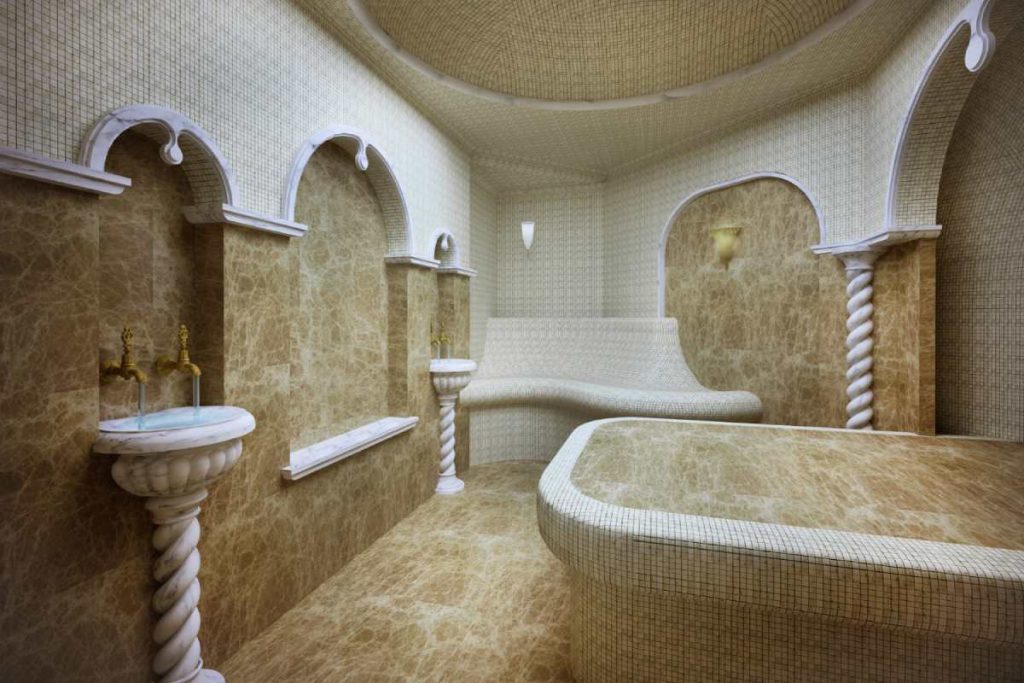Philosophy and Purpose of the Traditional Hammam
The Traditional Hammam is deeply rooted in cultural and communal practices. Its purpose is not just physical cleansing but also spiritual purification and social connection. In contrast, modern spas focus primarily on personal wellness, beauty, and relaxation. A visit to a Traditional Hammam feels more ritualistic and connected to tradition, while spas cater to individual comfort and luxury.
Treatments Offered in a Traditional Hammam Setting
A Traditional Hammam typically follows a fixed sequence of treatments: warm room relaxation, full-body scrub with a kese glove, foam massage, and rinsing. These steps are designed to detoxify and rejuvenate the body. Modern spas offer a wide range of customizable services, from facials and body wraps to aromatherapy. However, the Traditional Hammam focuses on time-tested techniques passed down through generations.
Atmosphere and Design of the Traditional Hammam
Walking into a Traditional Hammam is like stepping back in time. You’re met with marble interiors, domed ceilings, and echoes of flowing water. The design is focused on heat retention and spiritual ambiance. In contrast, modern spas often use contemporary materials, ambient lighting, and quiet music to create a serene, luxury-focused environment. The Traditional Hammam reflects its cultural heritage in both layout and sensory experience.
Thermal Experience in the Traditional Hammam vs Spa
The heat in a Traditional Hammam comes from steam-filled rooms that gradually warm the body, helping to open pores and promote detoxification. This natural, moist heat contrasts with modern spas, which may offer dry saunas, infrared cabins, or hot tubs. The consistent warmth and humidity of the Traditional Hammam provide a more immersive and skin-friendly experience.
Interaction and Privacy in the Traditional Hammam
In a Traditional Hammam, treatments are often done in open or semi-private spaces. Historically, it was a communal experience where people bathed and socialized together. While modern facilities may offer private hammam rooms, the traditional layout encourages interaction. Modern spas, on the other hand, prioritize privacy, offering secluded rooms and quiet zones. A Traditional Hammam invites shared cultural immersion, while spas focus on individual serenity.
Emotional and Cultural Value of the Traditional Hammam
Experiencing a Traditional Hammam connects you to centuries-old traditions, often linked to rites of passage, social gatherings, or religious customs. The emotional depth and cultural significance elevate it beyond just a wellness treatment. While modern spas provide physical and mental relaxation, the Traditional Hammam offers a spiritual and communal dimension rarely found in today’s spa culture.
Conclusion
Both the Traditional Hammam and modern spa offer valuable wellness experiences, but they differ greatly in philosophy, design, and purpose. The Traditional Hammam is ritualistic, communal, and deeply cultural, providing a holistic cleanse rooted in history. The modern spa is customizable, private, and designed for luxury and convenience. Choosing between the two depends on whether you seek tradition and connection or personalized relaxation and innovation.
Frequently Asked Questions
- What is the main difference between a Traditional Hammam and a spa?
A Traditional Hammam is rooted in cultural cleansing rituals, while a spa offers a range of modern, customized treatments. - Is the Traditional Hammam experience more intense than a spa?
Yes, the Traditional Hammam often includes vigorous scrubbing and high humidity, which may feel more intense than spa treatments. - Can I get a massage in a Traditional Hammam?
Yes, most Traditional Hammam rituals include a foam or oil massage as part of the process. - Are Traditional Hammams co-ed?
Typically no. A Traditional Hammam often has separate times or sections for men and women. - Is it okay to talk during the Traditional Hammam?
Minimal conversation is allowed, but many prefer silence to enhance the Traditional Hammam experience. - Do spas also offer hammam services?
Some modern spas feature hammam-inspired treatments, but they often lack the full Traditional Hammam sequence and authenticity. - Is there a spiritual aspect to the Traditional Hammam?
Yes, the Traditional Hammam is often tied to purification and cultural rituals, adding spiritual depth. - Can I combine spa and Traditional Hammam treatments?
Yes, some facilities offer packages that include both Traditional Hammam rituals and spa services. - Which is better for skin health: Hammam or spa?
The Traditional Hammam is excellent for deep exfoliation, while spas may offer advanced skincare options. - Is tipping expected in a Traditional Hammam?
Yes, tipping the attendant is a customary practice in the Traditional Hammam experience.
